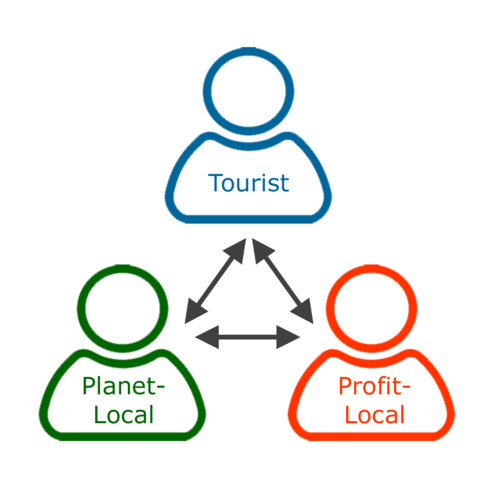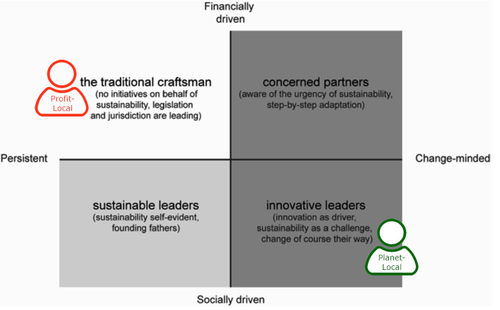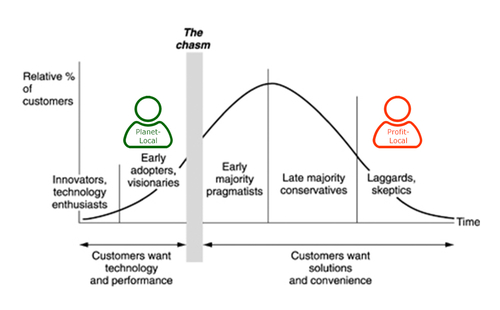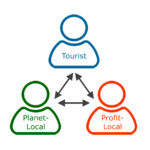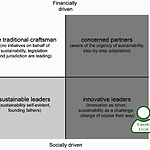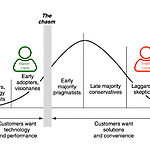1.2.1 Introduction
In the first paragraph the meaning of the socio-technical system was analyzed; it was described as the way the social and the technical system merged and came together. The social system by itself is about the interaction and exchange of services and goods between humans. The technical system provides the boundaries of these interaction, as they are often dependent on the available technologies. The socio-technical system is the infrastructure that technologies use to embed themselves in the existing culture, with the different options representing different alternatives. The particular system is then defined by the chosen option.
In this particular subsystem of ‘sustain lifestyles’, a lifestyle is defined as the choices the inhabitants of Texel make about all aspects of their lives, and the sustainability aspect is about whether or not this particular choice is ‘green’. One way to create this environment of inhabitants who exclusively choose sustainable, is simply by not making any unsustainable options available.
Both of these definitions are based around the choices the inhabitants of the island make. So lifestyle would in this case be the defining characteristic of the socio-technical system on Texel. In order to describe this system, we can look at the different lifestyles, and delineate their choices, and their interactions.
1.2.2 Subgroups lifestyles
To define these lifestyles, we must first separate them into different categories. There are two main groups that immediately stand out, namely the the locals and the tourists, and their many differences. Those who live on the island have a completely different point of view than those visitors who have no real connection or bond with the island. However a large part of the economy is based around the visits of these tourists, as every year the island sees over 700.000 of these tourists, compared to the locals, who number only 13.551(VVV Texel, 2015). This makes the wishes of the touristsone of the main influencing factors. Other than that, the locals are the target group with the actual power of decision.
Of course the locals themselves are too much of a varied group to simply lump them together, but we can divide them into two main factions: those who are already aware of sustainable options, and actively participate, the planet local, and those who are content with the current status quo of mass production and cheaper options, the profit local.
It is impossible to differentiate these groups based on any physical characteristics in location, employment or situation on the island, as there is none. These two target groups live integrated amongst each other, but are separated by this analysis based on their active choices.
The planet locals here are the frontrunners on sustainability, and their informed choices forces them to put extra effort into their daily life, but it does help them to put as small a burden on the environment as possible. The planet locals only exist in small numbers, compared to the much larger group of profit locals. The lifestyle of these profit locals is accepted as the current standard, and is in fact very similar to lifestyles all over the Netherlands.
The three lifestyles that can be defined in this model are:
- the planet local
- the profit local
- the tourist
See the Figure below (figures in the text are only visible if the article is opened by clicking on the title, expanding the article does not show the figures)
These three lifestyles are related to the triple P approach (Elkington, 1997), which will be elaborated further in chapter 1.4. After we have analyzed the socio-technical system with this three-grouped model, we take a look at two other models where society has been divided into different sections. Van Hall’s model about Target groups for sustainability (Van Hall, 2009) and Moore’s model on adoption speed (Moore, 1991)
1.2.2.1 Planet Locals
Even within the planet local group, there are different lifestyles, and their involvement in sustainability. The main difference can be seen if this group is split into two subgroups:
- producer
- consumer
The planet locals are a minority group, and the producers are a minority subgroup within this faction. It is much more expensive to produce local food in a sustainable way, especially without any municipality support or infrastructure in place, and not many of them make enough profit to do this as a full time job. This means for many of the planet consumers this is a hobby, or leftovers from their personal produce garden. In some cases it is also a side product of another goal. In practice this means there are almost no producers who spend their full attention on growing this local food. The fact that most of them only produce small quantities limits their efficiency, as this prevents them from using the modern agricultural technologies that allows other farmers to produce such massive quantities of goods. This means they spend a lot of effort on the limited goods they can offer, both in quantity and variety.
The result of this is that the planet consumers simply cannot get all of their goods from local, sustainable producers, and they have to shop at the big chains by necessity. This is the reason why none of the planet locals eat 100% sustainability and locally as of yet. However the thing that makes this target group sustainable is that whenever possible, make the sustainable choice.
The planet producers also have customers in the tourist group, which consists of eco, leisure and culture tourists. The ones interested in sustainability are exclusively the eco tourists, and the culture tourists, who are attracted to the local aspect of these goods. These tourists do more than just eat, and there are a few planet locals who earn their income by organizing sustainable activities on the island for these tourists.
Overall both of these subgroups are very limited in their sustainable aspirations and choices by the technological constraints.
1.2.2.2 Profit locals
The profit locals include by far the largest percentage of the locals, and as the name suggests, their focus is on ease and profit. Just like the planet locals, they are divided in two groups.
- producer
- consumer
In their case, they hold most of the big name retailers and mass productions, and they provide all goods people could have a need for on the island. They sell both those goods that can’t be bougth locally, as well as a cheaper version of those who can.
. As their goods are imported from worldwide, they are not bound by seasonal or spatial restrictions like the planet locals. All these goods are amassed in large retail shops.. This is unlike the local providers, who often sell small quantities from their homes.
Their main clientele consists of the the profit locals and the leisure tourists, though almost as often the planet locals, eco and culture tourists are forced to go there to buy products that would otherwise be unavailable to them.
The two local groups do mix, live together and interact, and can inform and influence each other. A percentage of the profit locals might be unaware of the unsustainability of their lifestyle, and aren’t aware of any alternative options. The interaction between these factions could provide them with information, which might end up making them more sustainable.
1.2.2.3 Tourists
This group is separate from both the planet locals and the profit locals, and they do not interact overly much. They have a very different mindset when they arrive on the island. Their ties to the island are weaker, or nonexistent, and only for the relatively short duration of their holidays.. Because of this, their main focus in coming to Texel is to provide themselves with pleasure. They do not produce any goods for the island, and only consume goods and services. To clarify this particular target group a bit more, we can split them in three subgroups, who each interact with the socio-technical system on Texel in slightly different ways.
- leisure tourists
- culture tourists
- eco tourists
While the eco tourists are mentioned as a subgroup, their number is either very small or nonexistent, as Texel does any prominence as a sustainable island, or one who offers much in the way of ecologically responsible activities. When this changes, their numbers might increase.
As of this moment, there isn’t much distinction in actions between the culture and the leisure groups, though the culture tourists are on Texel to enjoy the island, while the leisure tourists are really there to enjoy themselves.
The culture tourists went to Texel because they are interested in the culture and history of the island. They are interested, and appreciate local goods over general mass produced ones. If the activities and the lifestyle of the island progresses to become more sustainable, these tourists would be even more more enthusiastic about Texel.Leisure tourists are more difficult to sway, as they are on holiday for their own pleasure. For the foreseeable future, sustainable and local products will still be cost more, and require more effort to gather than non-sustainable ones. In the end, this particular subgroup of tourists will not choose the sustainable option, unless that is the only kind of option available.
See the figure below for the sub-groups:
Comparing the lifestyles to other conceptual models
Influence is one of the most important factors of governance, and creating a change in the socio-technical system. To understand this better, there are two other models, designed by well-known economists, who define the way this change towards sustainability we promote would actually happen, and which target groups will be a deciding factor here.
The first of these, made by Van Hall, divides the population into four target groups, defined not by their lifestyle choices, but by their role and their influence in the social system, who each have a different take on sustainability and financial matters.
These four groups are:
- the traditional craftsman
- the concerned partner
- the sustainable leader
- the innovative leader
If this model is compared with the categorization of lifestyles, the local profit can be placed in the upper part of the model, with the traditional craftsman and the concerned partners. The local planet can then be placed on the lower side of the model (sustainable leader). See the figure below.
Van Hall states in her paper 'The merger of interests' that, instead of the most obvious sustainable leader, the focus for changing potential has to be on the Concerned partner and the Innovative leader. These two parties are important because they aren’t committed yet, and instead are more or less 'fence-sitters' that are open for new ideas and willing to adopt them. The traditional craftsman is not a party interested in change, and in fact only changes when there is really no other option. The Planet locals fit best in the box of the sustainable leader, but as this model shows, they are already committed to sustainability, and while they lead as an example case, they aren’t the target group the whole sustainability strategy has to focus on, as effort in this group is much less effective than in the earlier mentioned target groups.
A second model that can be used to position the different lifestyles is the adoption-model of Moore, which can be seen in the figure below. In this model several consumer groups are described regarding their willingness to adopt a certain product or service. When we position the different lifestyle target groups in this model, the Local Profit will be part of the Late majority or Laggards and the Local Planet leads as an innovator and early adopter. Focus of change should be for the Local Planets to convince others to 'cross the chasm' and let their initiatives become more mainstream and adopted by the early and late majority. A second focus of change should be to stimulate the Local Profits to move from their position of Laggards to become the Late or even Early majority. See the figure below.
Conclusion
As the goal of this project is to create a sustainable Texel in 2065, a great number of things has to change. In the introduction we defined the sustainable lifestyle as the personal choices all inhabitants make every day. This makes the planet local the example case the other two target groups have to progress towards. In 2015, only a few subgroups consciously choose a sustainable lifestyle, but even then their options are limited.
If we just look at the number of subgroups, about 3-4 out of 7 groups pick the sustainable option wherever possible, which sounds better than expected. However, when we take the size of the various groups into account, only a very small number of humans is actually ‘green’. This particular way of analyzing the socio-technical system divides people according to their personal choices, but it says very little about the influence these choices have on other humans in their particular socio-technical sphere.
